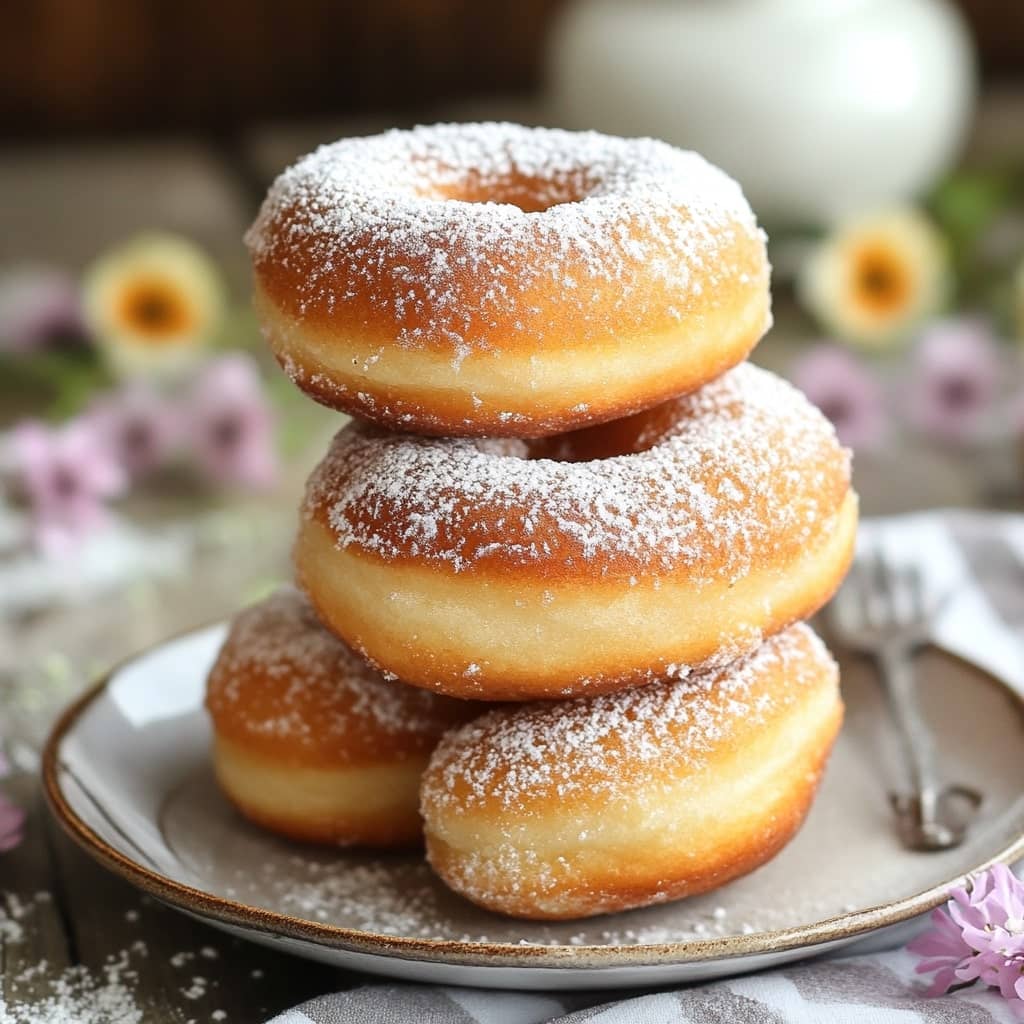Introduction:
Vanilla French beignets are a delightful pastry that is soft, fluffy, and coated in powdered sugar. These deep-fried treats are a classic French delicacy that traces its origins to the French Quarter of New Orleans, Louisiana, where they have become synonymous with the region’s unique culinary culture. Traditionally, beignets are enjoyed with coffee or hot chocolate, making them a perfect treat for breakfast or dessert. This version uses the subtle yet aromatic flavor of vanilla, elevating the taste of the beignets, making them even more irresistible.
The History of Beignets:
Beignets have a long history, originally coming from France, where they were made in various forms for centuries. The name “beignet” comes from the French word meaning “fried dough.” The tradition of frying dough in oil dates back to ancient times, with variations appearing in various European countries. Beignets became particularly famous in New Orleans, where French settlers introduced the pastry in the 18th century. In the heart of the French Quarter, beignets became an integral part of the city’s culture and are still served in many cafés today, most notably Café du Monde.
Ingredients Breakdown:
The key ingredients in Vanilla French Beignets are simple but essential to achieving the perfect texture and flavor. All-purpose flour provides the structure for the dough, while active dry yeast helps the dough rise, giving the beignets their fluffy texture. The warm milk, combined with the yeast, activates the dough, making it soft and easy to work with. Sugar is added for sweetness, and eggs contribute to the dough’s richness. A small amount of salt helps balance the flavors, while vanilla extract adds a lovely, fragrant note that defines these beignets. Finally, the beignets are fried in vegetable oil, which gives them a crispy golden exterior and a soft interior. After frying, the beignets are generously dusted with powdered sugar, creating a sweet contrast to the delicate dough.
Step-by-Step Recipe:
To start, activate the yeast by mixing it with warm milk and sugar. Allow the mixture to sit for about 5 minutes until it becomes frothy, which indicates that the yeast is active. In a large bowl, combine the flour, salt, eggs, and vanilla extract. Slowly add the yeast mixture to the dry ingredients, stirring to combine until the dough begins to form. Once combined, knead the dough on a floured surface for about 5 minutes until it is smooth and elastic. Cover the dough with a clean cloth and let it rise in a warm place for about 1 to 1.5 hours, or until it has doubled in size. Once the dough has risen, punch it down and roll it out to about 1/2-inch thickness. Cut the dough into squares or rectangles, and then carefully heat the vegetable oil in a deep fryer or large pot to 375°F (190°C). Fry the dough in batches for 2-3 minutes, or until the beignets are golden brown and puffed. Using a slotted spoon, remove the beignets from the oil and place them on paper towels to drain any excess oil. Once cooled slightly, dust them with a generous amount of powdered sugar before serving.
Tips for the Perfect Beignets:
To ensure your beignets turn out perfectly, it’s crucial to follow the recipe closely. First, make sure the yeast is properly activated by letting it sit in warm milk for the right amount of time. If the milk is too hot, it will kill the yeast, so be sure it’s warm, not boiling. Also, don’t skip the resting time for the dough. Giving it time to rise allows the yeast to work its magic, making the beignets fluffy and light. When frying, make sure the oil temperature stays consistent at 375°F (190°C). If the oil is too hot, the beignets will cook too quickly on the outside but remain raw on the inside. If it’s too cold, they will absorb too much oil and become greasy. Finally, make sure to dust the beignets with powdered sugar right before serving to keep them from becoming soggy.
Variations and Customizations:
While traditional vanilla beignets are delicious on their own, there are many ways to customize them to suit your preferences. For a chocolate twist, you can add cocoa powder to the dough for a chocolate-flavored base. You can also experiment with different extracts, such as almond or hazelnut, to give the beignets a different flavor profile. For a fruity variation, consider adding a handful of chopped fresh fruit, like raspberries or blueberries, into the dough. Some people like to fill their beignets with a sweet cream cheese or custard filling before frying, which creates a delightful surprise inside the pastry. If you prefer a lighter option, you could try making baked beignets instead of fried ones by placing them in a hot oven until golden brown.
Health Considerations and Nutritional Value:
Beignets are a decadent treat, so they should be enjoyed in moderation, especially if you’re watching your calorie intake. Fried foods like beignets tend to be higher in fat, so it’s important to balance them with a healthy diet and exercise. While beignets are delicious, they are high in sugar and refined carbohydrates, which can cause a spike in blood sugar levels if consumed in large quantities. If you’re looking for a healthier alternative, consider baking them instead of frying to reduce the amount of oil used. You can also try substituting some of the all-purpose flour with whole wheat flour to increase the fiber content. Additionally, you can reduce the sugar content by using a sugar substitute or reducing the amount of powdered sugar used for dusting.
FAQ:
- Can I make beignets ahead of time? Yes, you can make beignets ahead of time. Once fried, allow them to cool completely and store them in an airtight container at room temperature for up to 2 days. Reheat them in the oven before serving.
- Can I freeze beignets? Yes, you can freeze beignets. After frying, allow them to cool, then place them in an airtight container or freezer bag. Freeze for up to 2 months, and reheat in the oven before serving.
- Why are my beignets dense? If your beignets turned out dense, it could be due to under-proofing the dough, which means it didn’t have enough time to rise. Make sure to allow the dough to rest and rise properly.
- Can I use instant yeast instead of active dry yeast? Yes, you can use instant yeast in place of active dry yeast. Instant yeast does not need to be dissolved in warm liquid, so you can mix it directly into the dry ingredients.

Vanilla French Beignets
Ingredients
- 2.25 teaspoons active dry yeast
- 3/4 cup warm milk heated to 105°F
- 1 whole egg
- 1 egg yolk
- 3/4 cup granulated sugar
- 2 tablespoons unsalted butter softened
- 1.5 teaspoons vanilla extract
- 1/2 teaspoon kosher salt
- 3 cups all-purpose flour plus extra for dusting
- 2 cups vegetable oil for frying
- Powdered sugar for sprinkling on top
Instructions
- In a small bowl, combine the dry yeast with the warm milk. Stir lightly, then let the mixture sit for 10 minutes to activate the yeast.
- In the bowl of a stand mixer fitted with the paddle attachment, beat the softened butter and granulated sugar together until light and fluffy, about 2 minutes.
- Add the yeast mixture, egg, egg yolk, salt, and vanilla extract to the bowl. Set the mixer to low speed to combine.
- While the mixer is running, gradually add the flour. Continue mixing until the dough becomes smooth. Shape the dough into a round ball, then transfer it to a large, greased bowl. Cover with plastic wrap and let the dough rise in a warm place for about 1 hour, until it has expanded slightly.
- Turn the dough out onto a lightly floured surface and roll it into a 1/4-inch thick oval or rectangle. Use a 3-inch biscuit cutter to cut out rounds from the dough. Place the rounds onto a baking sheet lined with parchment paper. Cover loosely with plastic wrap and let them rest for 30 minutes.
- Heat the oil in a saucepan until it reaches 350°F, or until a scrap of dough dropped into the oil bubbles immediately. Fry the dough rounds in batches of 2 or 3 at a time, cooking each side until golden brown. Use a slotted spoon to transfer the beignets to a paper towel-lined plate to drain excess oil.
- Once the beignets are no longer hot but still warm, dust them generously with powdered sugar and serve immediately.

